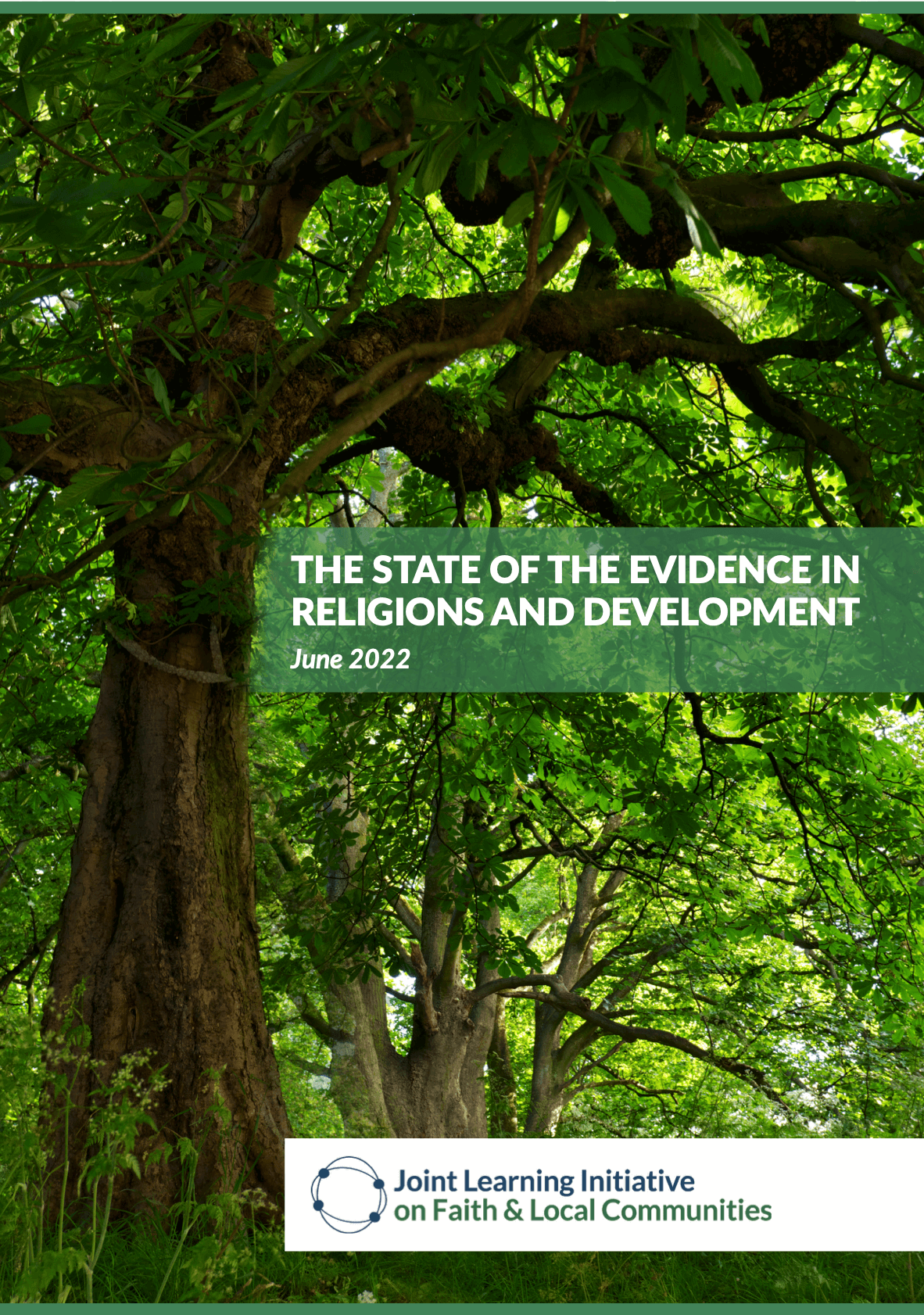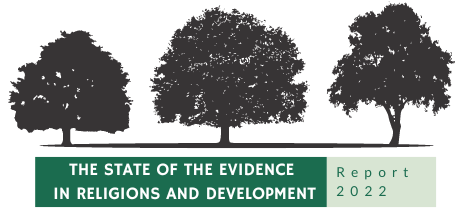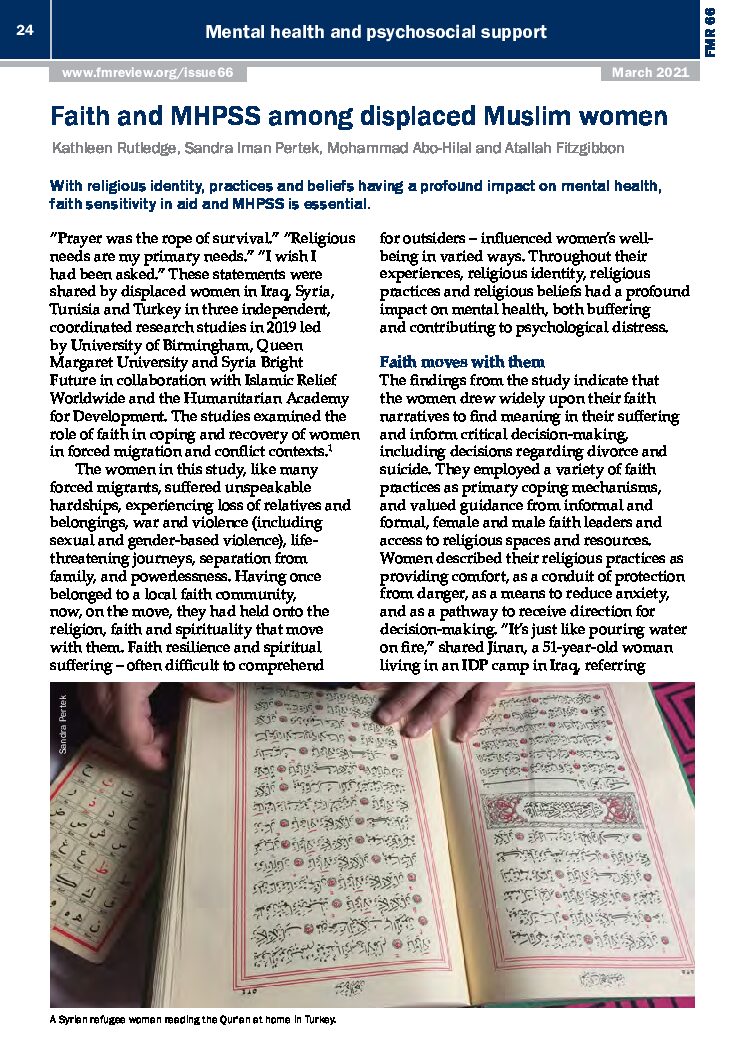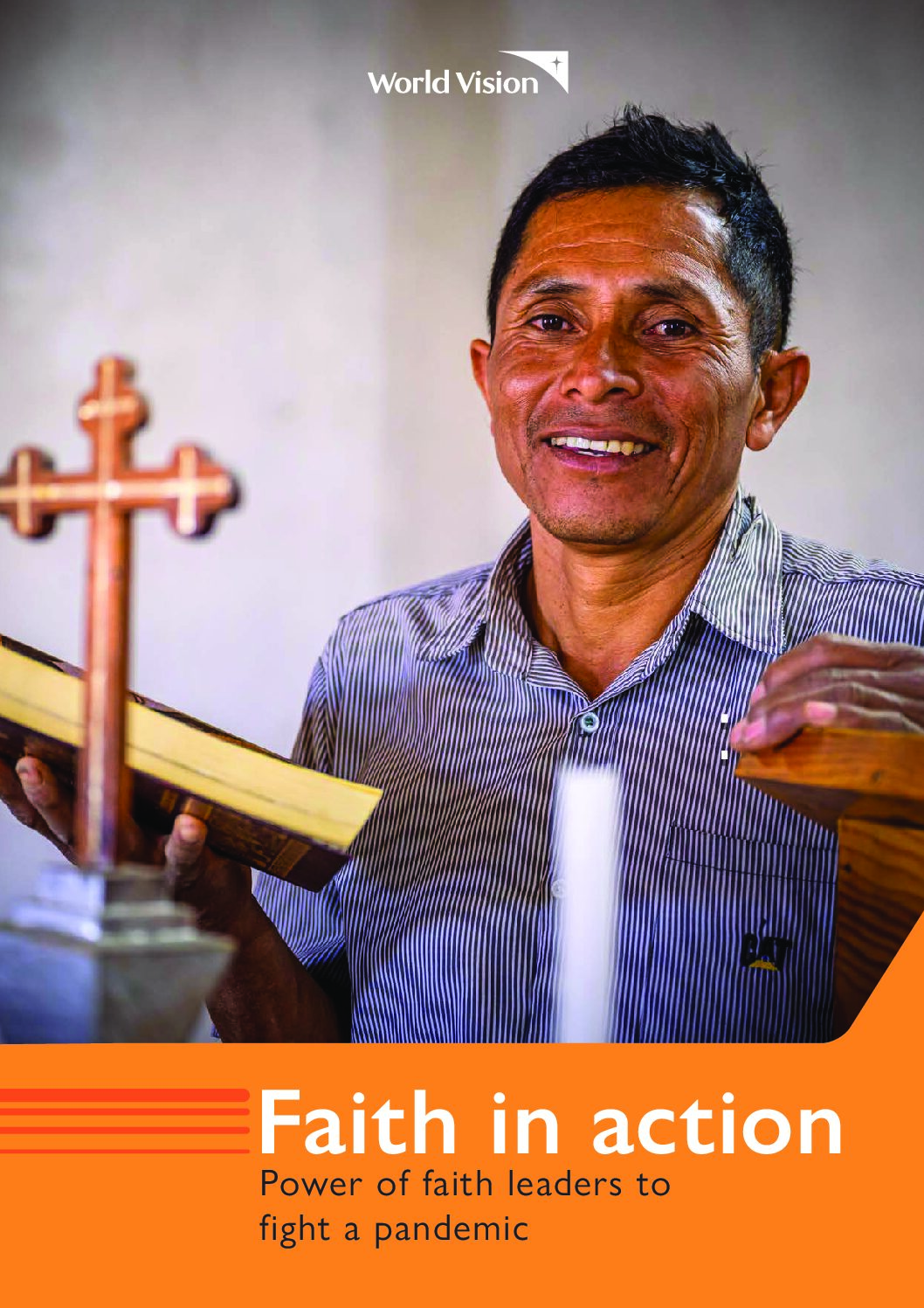An overview of the evidence base for religions and sustainable development, this flagship report from the JLI summarizes the evidence on religious activities in development in relation to health, the environment, gender, migration, peace and conflict, and violence against children. Reviewing research from authors around the world, this report helps you to quickly identify useful and trust-worthy evidence when considering the roles of religions in development.
Blog posts, videos, and summaries are in development and will be released throughout 2023. Please check back soon if you cannot find a resource immediately.
The report is now available in:
Suggested citation for the full report: Joint Learning Initiative on Faith and Local Communities, ed. The State of the Evidence in Religions and Development. Washington, DC: JLI, 2022.

Chapter 1: Introduction
Authors: Olivia Wilkinson, Susanna Trotta, Katherine Marshall, Ezra Chitando, Emma Tomalin
This chapter introduces the field of religions and development evidence. It defines “religions and development” as a field of study. It summarizes the major publications specific to religions and development in the last 20 years. It comments on current trends and publications in the field. Finally, it puts forward a common framework for defining faith actors, built from many publications that have proposed faith actor typologies.
You can read the chapter in full or access explanations of the chapter’s content in summary, blog, and video format here:
Suggested citation: Wilkinson, Olivia, Susanna Trotta, Katherine Marshall, Ezra Chitando, and Emma Tomalin. “Introduction.” In The State of the Evidence in Religions and Development, ed. Joint Learning Initiative on Faith and Local Communities (JLI). Washington, DC: JLI, 2022, 10-26.
Chapter 2: Religions, Health, and Development
Authors: John Blevins and Esther Mombo
This chapter discusses the evidence on religious actions for global health. It defines “religious health assets” and the influence of beliefs on health behaviors. It summarizes evidence on history of the intersection between health, development, and religions. It considers current trends and challenges including what has been left out of debates on religions and global health and where research should focus next.
You can read the chapter in full or access explanations of the chapter’s content in summary, blog, and video* format here:
Suggested citation: Blevins, John, and Ester Mombo. “Religions, Health, and Development.” In The State of the Evidence in Religions and Development, edited by Joint Learning Initiative on Faith and Local Communities (JLI), 28-33. Washington, DC: JLI, 2022, 27-32.
*Video links to previous events and webinars that help explain this subject
Chapter 3: Religions and the Environment
Authors: Philipp Öhlmann and Ignatius Swart
This chapter reflects on the evidence of the roles religions have played in the environment, climate change, and ecological sustainability. The chapter gives an overview of different religions’ approaches to the environment. It considers religions and the environment in relation to the Sustainable Development Goals (SDGs), the outsized role of Laudato Si and Catholic teachings, and religious takes on ecology.
You can read the chapter in full or access explanations of the chapter’s content in summary, blog, and video format here:
Suggested citation: Öhlmann, Philipp, and Ignatius Swart. “Religions and the Environment.” In The State of the Evidence in Religions and Development, edited by Joint Learning Initiative on Faith and Local Communities (JLI), 34-42. Washington, DC: JLI, 2022, 33-40.
Chapter 4: Faith Actors and Violence Against Children
Authors: Selina Palm and Kanykey Jailobaeva
This chapter starts by outlining the major statistics on the epidemic of violence against children around the world. Emerging from another scoping study on the topic, this chapter gives an overview of the literature in this field. It identifies several main trends in the evidence: international actors’ perspective predominates, an overemphasis on positive examples, and the need for further research and analysis on negative examples. There are several major current debates ongoing in the research in this field including the topics of corporal punishment, child sexual abuse, and th influence on faith actors on social norms at multiple levels.
You can read the chapter in full or access explanations of the chapter’s content in summary, blog, and video format here:
Suggested citation: Palm, Selina, and Kanykey Jailobaeva. “Faith Actors and Violence Against Children.” In The State of the Evidence in Religions and Development, edited by Joint Learning Initiative on Faith and Local Communities (JLI), 43-52. Washington, DC: JLI, 2022, 41-48.
Chapter 5: Religions, Development, and Gender
Authors: Elisabet Le Roux and Nora Khalaf-Elledge
This chapter summarizes the well-established area of gender, religions, and development. The authors identify that both religions and gender have been ignored in development and that both topics are often considered sensitive and controversial. The last 10 years has seen progress, however, with much of the literature recognising both the positive and negative potential of religions on gender equality. Some major recent trends include evidence and debate on sexual and reproductive health and rights (SRHR), LGBTQI+ rights, and problems with partnerships and fear of engagement among development actors on these topics.
You can read the chapter in full or access explanations of the chapter’s content in summary, blog, and video* format here:
Suggested citation: Le Roux, Elisabet, and Nora Khalaf-Elledge. “Religions, Development, and Gender.” In The State of the Evidence in Religions and Development, edited by Joint Learning Initiative on Faith and Local Communities (JLI), 52-58. Washington, DC: JLI, 2022, 49-54.
*Video links to previous events and webinars that help explain this subject
Chapter 6: Religions, Peace, and Conflict
Authors: Susan Hayward and Erin Wilson
This chapter recognises the varied and at times contentious history of debate on the role of religions in peace and conflict. It explains how debates have both overemphasized the positive and negative effects of religions in conflict, but that current research is trying to find a balance by paying attention to the nuances and complexities of each context. The chapter also discusses religious peacebuilding, Freedom of Religion and Belief, and ways to work on religions, peace, and conflict in sustainable development, including religious literacy approaches, how to work with faith networks, and evaluation of religious peace actions.
You can read the chapter in full or access explanations of the chapter’s content in summary, blog, and video* format here:
Suggested citation: Hayward, Susan, and Erin Wilson. “Religions, Peace, and Conflict.” In The State of the Evidence in Religions and Development, edited by Joint Learning Initiative on Faith and Local Communities (JLI), 59-64. Washington, DC: JLI, 2022, 55-60.
*Video links to previous events and webinars that help explain this subject
Chapter 7: Religions and Forced Migration
Authors: Susanna Trotta and Elena Fiddian-Qasmiyeh
This chapter looks at the evidence for the various roles of religions in displacement. The chapter first identifies the cases when religions are a cause for displacement, including challenges in understanding religious identity and claims of persecution. The chapter then goes on to highlight religious experiences of displacement, such as religious and spiritual coping for people experiencing trauma in migration. The chapter also discusses religion as a way to support integration in host communities for displaced people and faith-based responses to displacement from material support and shelter to advocacy for justice for refugees and migrants.
You can read the chapter in full or access explanations of the chapter’s content in summary, blog, and video* format here:
Suggested citation: Trotta, Susanna, and Elena Fiddian-Qasmiyeh. “Religions and Forced Migration.” In The State of the Evidence in Religions and Development, edited by Joint Learning Initiative on Faith and Local Communities (JLI), 65-73. Washington, DC: JLI, 2022, 61-68.
*Video links to previous events and webinars that help explain this subject
Navigate through the report online
Our intern, Yanwen Hui, a student from the University of Leeds, put together this video to introduce the State of the Evidence in Religions and Development report. Thank you to Yanwen for all her work on this!




